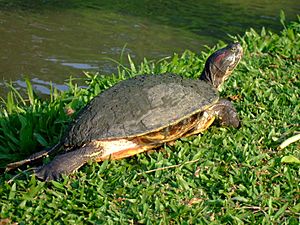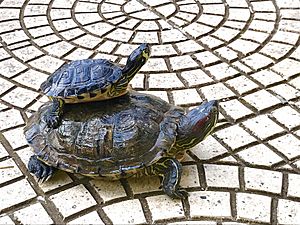Pond slider facts for kids
Quick facts for kids Pond slider |
|
|---|---|
 |
|
| Trachemys scripta elegans, the red-eared slider | |
| Conservation status | |
| Scientific classification | |
| Genus: |
Trachemys
|
| Species: |
scripta
|
 |
|
| Subspecies range map in the United States. Red: red-eared slider (also in Mexico) Yellow: yellow-bellied slider Blue: Cumberland slider |
|
The pond slider (Trachemys scripta) is a common, medium-sized turtle that lives partly in water and partly on land. There are three main types, or subspecies, of pond sliders. The most famous one is the red-eared slider. Many people keep red-eared sliders as pets. Sometimes, people let them go into the wild in places where they don't naturally live.
Young pond sliders have a green upper shell (called a carapace) and a yellow bottom shell (called a plastron). Their skin has green and yellow stripes and patterns. As they get older, these colors and patterns fade. Their upper shell might turn olive green, orange-brown, or brown. Their bottom shell becomes a dull yellow or darker. Some older sliders can even turn almost completely black.
The upper shell of a pond slider is usually oval and a bit rounded. It might have small bumps when the turtle is young. As they grow, their shells become smoother and flatter. To tell if an adult slider is a male or female, look at their front claws. Males usually have much longer front claws than females. Females often have shorter, thinner tails than males. Pond sliders can live for a long time, from 20 to 50 years.
Contents
Why are they called 'sliders'?
Pond sliders get their name from how they act when they get scared. These turtles, and many other types of freshwater turtles, love to bask in the sun. You can often see groups of them, sometimes very large groups, resting on logs, branches, or plants near or even above the water. But if they sense danger, they quickly slide back into the water. They dart away to safety underwater very fast!
Where do pond sliders live?
Pond sliders are originally from the south-central and southeastern parts of the United States. They also live in northern Mexico.
Pond sliders as invasive species
In the 1900s, many pond sliders were caught and sold as pets. By the 1950s, millions of these turtles were being raised on farms and sent to other countries for the pet trade.
When pond sliders are released into new places, they can become an invasive species. This means they can cause problems for the animals that naturally live there. Pond sliders often compete with native turtles and other animals for food, places to live, and other important things.
They can also push native species away from good basking spots. Basking in the sun helps turtles stay warm. Pond sliders sometimes bask on bird nests, which can accidentally harm or kill the eggs. They might also eat young birds.
Turtles raised by people can sometimes carry diseases that native animals have never been exposed to. These diseases can be very harmful to the local wildlife. People often release pet turtles because they become too big or too much work to care for. Sometimes, pet turtles also escape on their own.
Animal experts have warned pet owners not to release their turtles into the wild. Many states have also made laws to control how people own and release pond sliders. Some states have even completely stopped the sale of these turtles.
Types of pond sliders
There are three main types, or subspecies, of pond sliders:
- T. s. scripta – This is known as the yellow-bellied slider.
- T. s. elegans – This is the red-eared slider, which is very popular as a pet.
- T. s. troostii – This is called the Cumberland slider.
Sometimes, yellow-bellied and red-eared sliders can have babies together. This happens in places where both types of turtles live.
Images for kids
See also
 In Spanish: Galápago de Florida para niños
In Spanish: Galápago de Florida para niños




